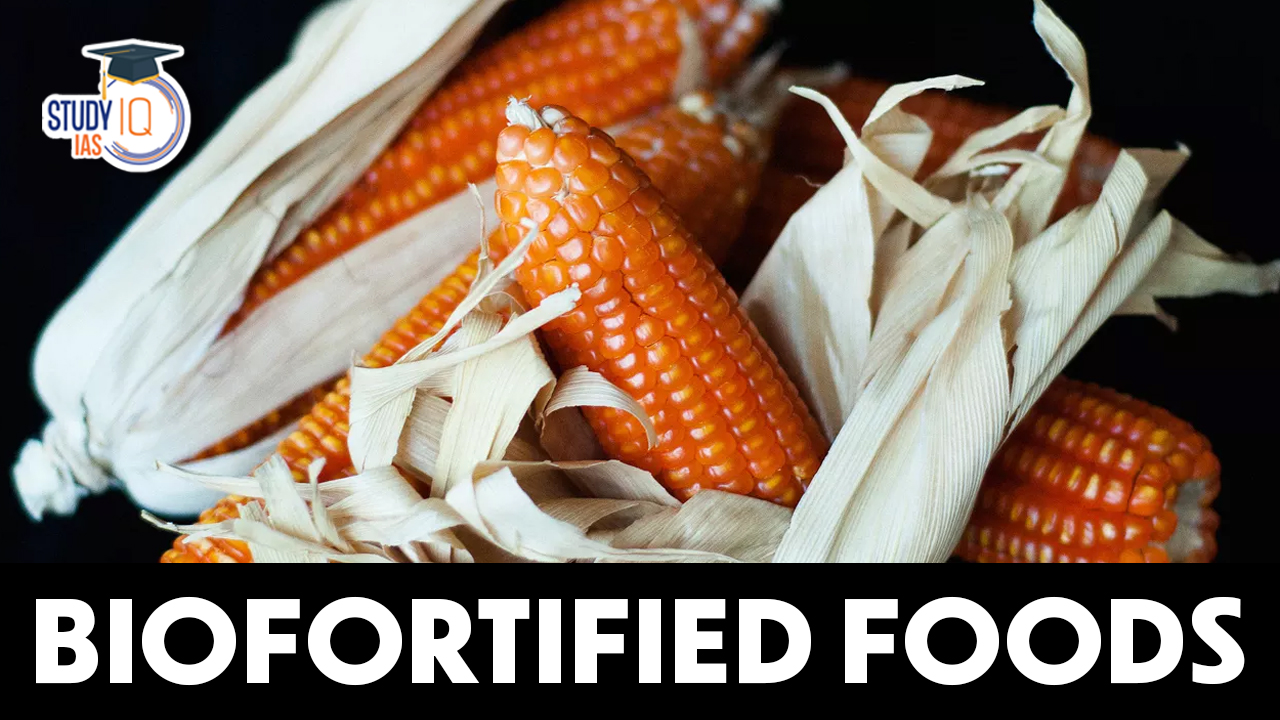Table of Contents
Context: The Federation of Indian Chambers of Commerce and Industry (FICCI) has released a report titled ‘Biofortification- A Pathway to Improve India’s Nutritional Outcomes’, highlighting the steps needed to promote the biofortification market in India.
What are Biofortified Foods?
- Biofortified foods are crops that have been deliberately bred and developed to have higher nutritional content compared to their conventional counterparts.
- The process of biofortification involves using conventional plant breeding techniques to enhance the concentration of essential vitamins, minerals, and other nutrients in food crops.
- The goal is to address micronutrient deficiencies, also known as hidden hunger, which affect millions of people around the world, particularly in developing countries.
Techniques of Biofortification
- Conventional Breeding: This approach involves traditional plant breeding methods to crossbreed crops with naturally higher levels of specific nutrients with locally adapted and widely grown varieties. The aim is to transfer the desired traits, such as increased vitamin or mineral content, to the new crop varieties.
- Selective Breeding: Researchers identify and select crop varieties with naturally higher nutrient content, known as donor or parent lines. These lines are then crossbred with local varieties to create new hybrids with improved nutritional profiles.
- Backcrossing: This technique involves crossing a biofortified crop with a locally adapted variety for several generations while selecting for the desired nutrient content.
- Marker-Assisted Selection (MAS): To speed up the breeding process, genetic markers associated with the desired nutrient traits are identified and used to select and track the presence of these traits in the offspring.
- Biotechnology: In some cases, genetic engineering techniques are used to introduce specific genes responsible for nutrient production into the crop’s genome. This approach allows for more precise control over the nutrient content, but it is subject to rigorous regulatory scrutiny.
- Transgenic Approach: Scientists introduce genes from other organisms into the plant’s genome, which encode enzymes or proteins involved in the synthesis of specific nutrients. This leads to the production of the desired nutrient in the crop itself.
- Gene Editing (CRISPR-Cas9): This advanced biotechnological tool allows for targeted modifications of specific genes in the crop’s genome to enhance nutrient content.
- Hybridization: This technique involves crossing two genetically distinct parent lines to produce hybrid seeds with improved nutritional characteristics compared to the original varieties.
- Mutagenesis: In this approach, plants are exposed to mutagenic agents (e.g., radiation or chemicals) to induce random genetic mutations. These mutations can sometimes lead to beneficial traits, such as increased nutrient content, which are then selected and propagated.
Benefits of Biofortified Foods
The significance of food fortification lies in its potential to address and alleviate various nutrient deficiencies in populations, contributing to improved public health and well-being.
- Combating Micronutrient Deficiencies:
- Food fortification targets specific micronutrients that are crucial for human health, such as iron, folic acid, vitamin A, iodine, and others.
- Micronutrient deficiencies can lead to a range of health issues, including impaired cognitive development, weakened immune systems, and increased susceptibility to diseases.
- Improved Overall Health:
- By fortifying staple foods with essential nutrients, the overall health of the population can be enhanced.
- For example, fortifying wheat flour or rice with iron and other micronutrients can help combat anemia and improve cognitive function.
- Cost-Effective and Sustainable:
- Food fortification is a cost-effective and sustainable approach to improving nutrition.
- Once the fortified seed or product is developed, it can be easily replicated and distributed without significant additional costs, making it accessible to broader populations, including low-income groups.
- No Behavior Change Required:
- Unlike other interventions that may require behavior change, such as dietary modifications or adherence to supplement regimens, food fortification doesn’t demand any change in eating habits.
- Reach Vulnerable Populations:
- Fortified foods can be particularly beneficial for reaching vulnerable groups, such as pregnant women, infants, and children, who are more susceptible to nutrient deficiencies.
- It can also help address malnutrition in regions with limited access to diverse and nutritious food options.
- Complementary to Other Interventions: Food fortification complements other nutrition interventions, such as supplementation and dietary diversification, creating a comprehensive approach to combat malnutrition.
Biofortified Foods in India
- Scientists at the Indian Council of Agricultural Research (ICAR) have been developing biofortified crops in India with a view to eradicating malnutrition amongst the poor sections of the society.
- As per the ICAR website, they had developed 21 varieties of biofortified staples including wheat, rice, maize, millets, mustard, groundnut by 2019-20.
- These biofortified crops have 1.5 to 3 times higher levels of protein, vitamins, minerals and amino acids compared to the traditional varieties.
Need for Biofortification in India
- India faces a development paradox—of being one of the fastest-growing global economies in the world and contrast—of having an estimated 189.2 million people i.e. 14% of the population as undernourished.
- Further, the percentage of children under the age of five who are stunted, wasted and are underweight are 38.4, 21.0 and 42.5 respectively.
- Also, 53.1% of women of reproductive age between 15 to 49 years are Anaemic. These metrics highlight the prevalence of chronic malnourishment of women, girls and children in India.
- Furthermore, COVID-19 has exacerbated the malnutrition status of vulnerable communities in India weakening their immunity.
Challenges for Biofortified Foods in India
- Consumer Acceptance: One of the significant challenges is the lack of consumer acceptance, particularly when it comes to changes in the appearance, taste, or texture of biofortified foods.
- For example, the “golden rice,” which is genetically modified to produce beta-carotene (provitamin A), faced resistance due to its yellowish color, even though it addresses vitamin A deficiency.
- Last Mile Reach and Accessibility: Ensuring that biofortified foods reach the most vulnerable and nutritionally deficient populations in remote and rural areas can be a logistical challenge.
- Farmer Adoption and Cost: Farmers may be hesitant to switch from their traditional crops to new biofortified varieties due to uncertainties about crop performance, market demand, and potential changes in farming practices.
- Additionally, the initial costs of acquiring biofortified seeds or materials might be a concern for resource-limited farmers.
- Time and Resources for Non-GMO Methods: While biofortification using non-genetically-modified methods is generally considered safe and more widely accepted by some consumers, it can be a slower and resource-intensive process compared to genetic modification.
- Risk of Excess Iron: For certain segments of the population, such as men and individuals with certain medical conditions like thalassemia and sickle cell anemia, excessive iron intake through fortified foods may pose health risks. High iron levels have been associated with an increased risk of chronic diseases like diabetes and hypertension.
Government Initiatives related to Biofortification
- National Agricultural Research System (NARS): The government collaborates with NARS to develop and release biofortified crop varieties that are rich in essential micronutrients such as iron, zinc, and vitamin A. These varieties are aimed at improving the nutritional content of commonly consumed staple crops.
- HarvestPlus: HarvestPlus is a global initiative working in partnership with national and international organizations to promote biofortification. In India, HarvestPlus works with research institutions and agricultural organizations to develop and disseminate biofortified crop varieties.
- National Nutrition Strategy (NNS): The NNS recognizes the significance of biofortification in addressing malnutrition and aims to promote the cultivation and consumption of biofortified crops to improve the nutritional intake of vulnerable populations.
Way Forward: Recommendations by the FICCI Report
- Marketing-supply-policy support-institutional strengthening (MSPI) strategy to achieve the goal of scaling up biofortification is the need of the hour.
- Market drive for sustainable growth is critical and can be achieved through solutions such as direct farm gate purchase, increase consumer awareness, proper labelling and packaging;
- While the supply drive can be strengthened through improving farmer acceptance and awareness, developing a robust value chain and a brand differentiator through logo to label biofortified foods.



 UPSC CDS 1 Final Result 2025 Declared: D...
UPSC CDS 1 Final Result 2025 Declared: D...
 Ramsar Sites in India 2025 List: Names, ...
Ramsar Sites in India 2025 List: Names, ...
 SEBI’s SWAGAT-FI Framework for Low-Ris...
SEBI’s SWAGAT-FI Framework for Low-Ris...

























